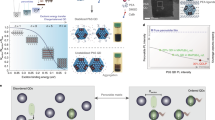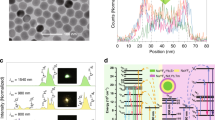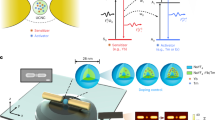Abstract
Visible nanocrystal-based light-emitting diodes (LEDs) are about to become commercially available. However, their infrared counterparts suffer from two key limitations. First, III–V semiconductor technologies are strong competitors. Second, their potential for operation beyond 1.7 µm remains unexplored. The range from 1.5 to 4 µm corresponds to a technological gap in which the efficiency of interband quantum-well-based devices vanishes and quantum cascade lasers are not efficient enough. Powerful infrared LEDs in this range are needed for applications such as active imaging, organic molecule sensing and airfield lighting. Here we report the design of a HgTe nanocrystal-based LED with luminescence between 2 and 2.3 µm. With an external quantum efficiency of 0.3% and radiance up to 3 W Sr−1 m−2, these HgTe LEDs already present a competitive performance for emission above 2 µm.
This is a preview of subscription content, access via your institution
Access options
Access Nature and 54 other Nature Portfolio journals
Get Nature+, our best-value online-access subscription
$29.99 / 30 days
cancel any time
Subscribe to this journal
Receive 12 print issues and online access
$209.00 per year
only $17.42 per issue
Buy this article
- Purchase on Springer Link
- Instant access to full article PDF
Prices may be subject to local taxes which are calculated during checkout





Similar content being viewed by others
Data availability
The data that support the findings of this study are available upon reasonable request. Source data are provided with this paper.
Change history
11 January 2022
In the version of this article initially published, there was an omission in affiliation 2. The affiliation has been corrected in the html and PDF versions of this article as of 11 January 2022.
References
Nizamoglu, S., Ozel, T., Sari, E. & Demir, H. V. White light generation using CdSe/ZnS core–shell nanocrystals hybridized with InGaN/GaN light emitting diodes. Nanotechnology 18, 065709 (2007).
Wood, V. & Bulović, V. Colloidal quantum dot light-emitting devices. Nano Rev. 1, 5202 (2010).
Liu, B. et al. Record high external quantum efficiency of 19.2% achieved in light-emitting diodes of colloidal quantum wells enabled by hot-injection shell growth. Adv. Mater. 32, 1905824 (2020).
Tessler, N., Medvedev, V., Kazes, M., Kan, S. & Banin, U. Efficient near-infrared polymer nanocrystal light-emitting diodes. Science 295, 1506–1508 (2002).
Pradhan, S. et al. High-efficiency colloidal quantum dot infrared light-emitting diodes via engineering at the supra-nanocrystalline level. Nat. Nanotechnol. 14, 72–79 (2019).
Vasilopoulou, M. et al. Efficient colloidal quantum dot light-emitting diodes operating in the second near-infrared biological window. Nat. Photon. 14, 50–56 (2020).
Wei, Y.-C. et al. Overcoming the energy gap law in near-infrared OLEDs by exciton–vibration decoupling. Nat. Photon. 14, 570–577 (2020).
Faist, J. et al. Quantum cascade laser. Science 264, 553–556 (1994).
Adelin, B. et al. Electrically pumped all photonic crystal 2nd order DFB lasers arrays emitting at 2.3 μm. APL Photon. 2, 036105 (2017).
Kim, M. et al. Interband cascade laser emitting at λ = 3.75 μm in continuous wave above room temperature. Appl. Phys. Lett. 92, 191110 (2008).
Vurgaftman, I., Meyer, J. R. & Ram-Mohan, L. R. High-power/low-threshold type-II interband cascade mid-IR laser-design and modeling. IEEE Photon. Technol. Lett. 9, 170–172 (1997).
Kasper, E. & Oehme, M. Germanium tin light emitters on silicon. Jpn. J. Appl. Phys. 54, 04DG11 (2015).
Stange, D. et al. Short-wave infrared LEDs from GeSn/SiGeSn multiple quantum wells. Optica 4, 185–188 (2017).
Triki, M., Nguyen, Ba,T. & Vicet, A. Compact sensor for methane detection in the mid infrared region based on quartz enhanced photoacoustic spectroscopy. Infrared Phys. Technol. 69, 74–80 (2015).
Rastogi, P. et al. Complex optical index of HgTe nanocrystal infrared thin films and its use for short wave infrared photodiode design. Adv. Opt. Mater. 9, 2002066 (2021).
Gréboval, C. et al. Mercury chalcogenide quantum dots: material perspective for device integration. Chem. Rev. 121, 3627–3700 (2021).
Keuleyan, S., Lhuillier, E. & Guyot-Sionnest, P. Synthesis of colloidal HgTe quantum dots for narrow mid-IR emission and detection. J. Am. Chem. Soc. 133, 16422–16424 (2011).
Zhang, H. & Guyot-Sionnest, P. Shape-controlled HgTe colloidal quantum dots and reduced spin-orbit splitting in the tetrahedral shape. J. Phys. Chem. Lett. 11, 6860–6866 (2020).
Prado, Y. et al. Seeded growth of HgTe nanocrystals for shape control and their use in narrow infrared electroluminescence. Chem. Mater. 33, 2054–2061 (2021).
Keuleyan, S., Kohler, J. & Guyot-Sionnest, P. Photoluminescence of mid-infrared HgTe colloidal quantum dots. J. Phys. Chem. C 118, 2749–2753 (2014).
Melnychuk, C. & Guyot-Sionnest, P. Slow Auger relaxation in HgTe colloidal quantum dots. J. Phys. Chem. Lett. 9, 2208–2211 (2018).
Lim, J. et al. Ultrafast intraband Auger process in self-doped colloidal quantum dots. Matter 4, 1072–1086 (2021).
Boschetto, D. et al. Small atomic displacements recorded in bismuth by the optical reflectivity of femtosecond laser-pulse excitations. Phys. Rev. Lett. 100, 027404 (2008).
Geiregat, P. et al. Continuous-wave infrared optical gain and amplified spontaneous emission at ultralow threshold by colloidal HgTe quantum dots. Nat. Mater. 17, 35–42 (2018).
Al-Otaify, A. et al. Multiple exciton generation and ultrafast exciton dynamics in HgTe colloidal quantum dots. Phys. Chem. Chem. Phys. 15, 16864–16873 (2013).
Qu, J. et al. Electroluminescence from HgTe nanocrystals and its use for active imaging. Nano Lett. 20, 6185–6190 (2020).
Chuang, C.-H. M., Brown, P. R., Bulović, V. & Bawendi, M. G. Improved performance and stability in quantum dot solar cells through band alignment engineering. Nat. Mater. 13, 796–801 (2014).
Greboval, C. et al. Infrared narrow band gap nanocrystals: recent progresses relative to imaging and active detection. Preprint at https://arxiv.org/abs/2001.11554 (2020).
Svane, A. et al. Quasiparticle band structures of β-HgS, HgSe and HgTe. Phys. Rev. B 84, 205205 (2011).
Delin, A. & Klüner, T. Excitation spectra and ground-state properties from density-functional theory for the inverted band-structure systems β-HgS, HgSe and HgTe. Phys. Rev. B 66, 035117 (2002).
Allan, G. & Delerue, C. Tight-binding calculations of the optical properties of HgTe nanocrystals. Phys. Rev. B 86, 165437 (2012).
Lhuillier, E., Keuleyan, S. & Guyot-Sionnest, P. Optical properties of HgTe colloidal quantum dots. Nanotechnology 23, 175705 (2012).
Moghaddam, N. et al. The strong confinement regime in HgTe two-dimensional nanoplatelets. J. Phys. Chem. C 124, 23460–23468 (2020).
Rogach, A. et al. Colloidally prepared HgTe nanocrystals with strong room-temperature infrared luminescence. Adv. Mater. 11, 552–555 (1999).
Rogach, A. L., Koktysh, D. S., Harrison, M. & Kotov, N. A. Layer-by-layer assembled films of HgTe nanocrystals with strong infrared emission. Chem. Mater. 12, 1526–1528 (2000).
Sergeev, A. A. et al. Tailoring spontaneous infrared emission of HgTe quantum dots with laser-printed plasmonic arrays. Light Sci. Appl. 9, 16 (2020).
Zhao, Y., Wang, V., Lien, D.-H. & Javey, A. A generic electroluminescent device for emission from infrared to ultraviolet wavelengths. Nat. Electron. 3, 612–621 (2020).
O’Connor, É. et al. Near-infrared electroluminescent devices based on colloidal HgTe quantum dot arrays. Appl. Phys. Lett. 86, 201114 (2005).
Koktysh, D. S. et al. Near-infrared electroluminescence from HgTe nanocrystals. ChemPhysChem 5, 1435–1438 (2004).
Maniyara, R. A. et al. Highly transparent and conductive ITO substrates for near infrared applications. APL Mater. 9, 021121 (2021).
Pradhan, S., Dalmases, M. & Konstantatos, G. Solid-state thin-film broadband short-wave infrared light emitters. Adv. Mater. 32, 2003830 (2020).
Amelot, D. et al. Revealing the band structure of FAPI quantum dot film and its interfaces with electron and hole transport layer using time resolved photoemission. J. Phys. Chem. C 124, 3873–3880 (2020).
Gréboval, C. et al. Time-resolved photoemission to unveil electronic coupling between absorbing and transport layers in a quantum dot-based solar cell. J. Phys. Chem. C 124, 23400–23409 (2020).
Livache, C. et al. Charge dynamics and optolectronic properties in HgTe colloidal quantum wells. Nano Lett. 17, 4067–4074 (2017).
Gréboval, C. et al. Impact of dimensionality and confinement on the electronic properties of mercury chalcogenide nanocrystals. Nanoscale 11, 3905–3915 (2019).
Bergeard, N. et al. Time-resolved photoelectron spectroscopy using synchrotron radiation time structure. J. Synchrotron Rad. 18, 245–250 (2011).
Acknowledgements
We thank P. Hollander and D. Henry for experimental support. The project is supported by ERC starting grant blackQD (grant no. 756225, E.L.) and Ne2Dem (grant no. 853049, S.I.). We acknowledge the use of clean-room facilities at the Centrale de Proximité Paris-Centre. This work has been supported by the Region Île-de-France in the framework of DIM Nano-K (grant dopQD, E.L.) and in the framework of the SESAME Electrophonon (grant no. 14014520, D.B.). We acknowledge financial support from the French Department of Defence (DGA) in the frame of the Oscillateur térahertz project (grant no. 2018 60 0071 00 470 75 01, D.B.), and of PALM in the framework of the TPS grant (grant no. ANR‐10‐LABX‐0039‐PALM, D.B.). This work was supported by French state funds managed by the ANR within the Investissements d’Avenir programme under reference ANR-11-IDEX-0004-02 (E.L.) and, more specifically, within the framework of the Cluster of Excellence MATISSE and also by the grant IPER-Nano2 (ANR-18CE30-0023-01, E.L.), Copin (ANR-19-CE24-0022, E.L.), Frontal (ANR-19-CE09-0017, M.G.S.), Graskop (ANR-19-CE09-0026, E.L.), TOCYDYS (ANR-19-CE30-0015-03, D.B.) and NITQuantum (ANR-20-ASTR-0008-01, E.L.), Bright (ANR-21-CE24-0012-02, E.L.) and MixDFerro (ANR-21-CE09-0029, E.L.). J.Q. thanks the Chinese Scholarship Council for PhD funding and A.C. thanks Agence Innovation Defense.
Author information
Authors and Affiliations
Contributions
E.L. designed the project. J.Q. and Y.P. grew the nanocrystals with the support of E.I. and S.I. G.P. conducted TEM imaging. J.Q. fabricated the diode with the support of E.B. J.Q. and E.B. characterized the diode with the support of A.C. and G.V. for infrared camera imaging. D.B., M.W., S.G.M. and E.B. measured the EL spectra. Synchrotron measurements were performed by C.G., C.D. and M.G.S. M.W., S.G.M., E.P. and D.B. conducted the transient reflectivity measurements. All authors discussed the results. E.L. wrote the manuscript with input from all other authors.
Corresponding author
Ethics declarations
Competing interests
The authors declare no competing interests.
Additional information
Peer review information Nature Photonics thanks Ni Zhao and the other, anonymous, reviewer(s) for their contribution to the peer review of this work.
Publisher’s note Springer Nature remains neutral with regard to jurisdictional claims in published maps and institutional affiliations.
Supplementary information
Supplementary Information
Supplementary Figs. 1–23, Discussion and Tables 1 and 2.
Source data
Source Data Fig. 1
Data from Fig. 1a,b,d,e.
Source Data Fig. 2
Data from Fig. 2d,e.
Source Data Fig. 3
Data from Fig. 3a.
Source Data Fig. 4
Data from Fig. 4b–e.
Source Data Fig. 5
Data from Fig. 5a,b,d,e.
Rights and permissions
About this article
Cite this article
Qu, J., Weis, M., Izquierdo, E. et al. Electroluminescence from nanocrystals above 2 µm. Nat. Photon. 16, 38–44 (2022). https://doi.org/10.1038/s41566-021-00902-y
Received:
Accepted:
Published:
Issue Date:
DOI: https://doi.org/10.1038/s41566-021-00902-y



